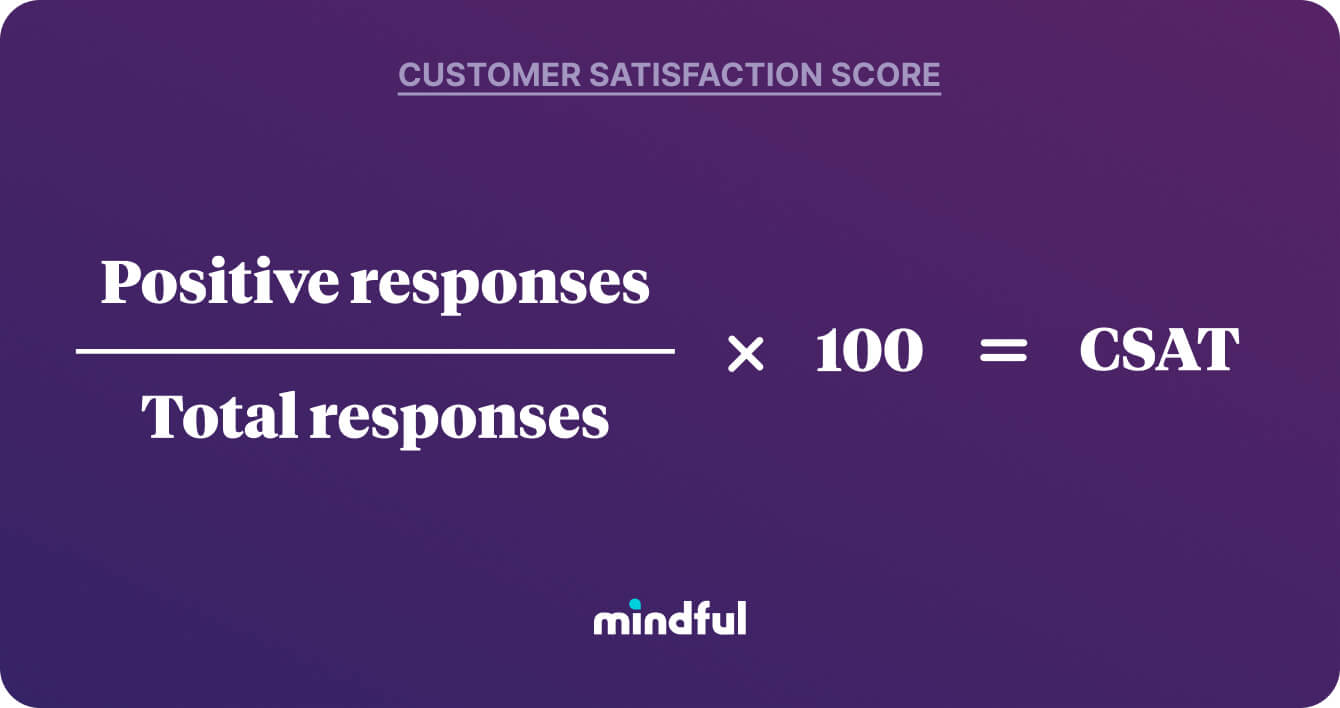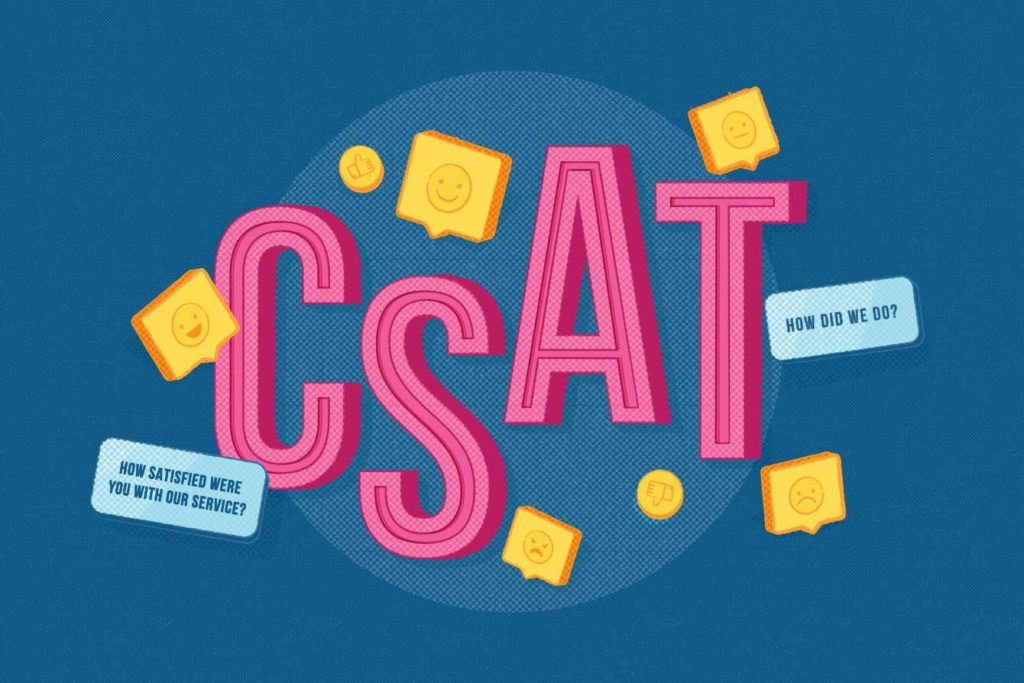Customer satisfaction should be the number one goal of any customer service professional. But short of calling up every customer and asking, it’s time consuming and difficult to understand how a customer feels. How can you get into your customer’s headspace without being too intrusive?
CSAT surveys, which are the key to building positive customer relationships, are the best way to accomplish this. But effectively using them means knowing your customer and identifying which questions to ask and when to ask them. Here are a few examples of questions, including the most commonly asked on CSAT, NPS, and CES surveys.
Breaking down CSAT surveys
Although there are many different metrics that help you identify a customer’s interest in your product or service, there are three key metrics that CX (customer experience) teams use most often—the CSAT (Customer Satisfaction) score, NPS (Net Promoter Score), and CES (Customer Effort Score). These three metrics will tell you how much a customer likes your product or service, if they’re willing to share their experience with others, and how hard it was for them to use it. When used in combination, this data gives a fairly well-rounded picture of the customer’s headspace.
| CSAT | NPS | CES | |
| Asks the question: | Do you like or are you satisfied with our product? | Would you suggest our product / service to a friend or colleague? | How hard was it to use our product or get your issue resolved? |
| Shows you: | If your product / service is well-received. | If you can get new customers by word of mouth. | What areas need improvement to resolve problematic ease-of-use cases. |
| Builds positive customer relationships by: | Letting people talk about how they like—or don’t like—your product / service. | Getting people excited and talking. | Letting customers know you care and will work to rectify negative situations. |
The benefits of CSAT survey data
Customer satisfaction has become a huge driver for revenue. According to Gartner, 89% of businesses are expected to compete mainly on customer experience. That kind of competition means that companies will go to great lengths to invest and develop customer satisfaction strategies, and that means having data metrics like CSAT, NPS, and CES at their fingertips.
It also helps to have these metrics on hand when developing new strategies. Should you focus your teams on product development? Your CSAT scores will help you by showing if people like it the way that it is, or if they want something different. Should you work some surprise and delight? A low or mediocre NPS score may suggest that customers feel passive toward your brand and could use some magic in their experience. CES spiraling downward? Take a look at the processes and CX teams, and see if you should reallocate resources there.
What survey data can’t tell you about customers
Before digital transformation took over companies, word of mouth and customer surveys were mostly done by phone or in-person (and they still are, in some cases). Disney, for example, has survey teams that use digital pads to capture survey questions while people are enjoying the parks. With the advent of digital survey methods, the data is getting easier and easier to collect. But the data, while accurate, doesn’t give 100% of the customer picture.
The data won’t tell you how the customer got to their current relationship with you. Did they buy from you before? Did a friend refer them? Do they frequent other businesses like yours? Do they dislike your company’s carbon footprint? The stats tell you what a customer feels, but not why they feel that way. To get a complete picture of your customer and to aid you in your strategies to serve them better, you might want to investigate other metrics that give a deeper insight into your customer.
What kinds of survey questions should you ask?
Before you begin to craft your surveys, you should never start by asking, “What questions am I going to ask?” Instead, begin by discussing, “What do I want to know?” You may only get one chance at a good impression. And since the quality of the answer will directly correlate to the quality of the response, you don’t want to risk asking an obvious or trite question.
Making sure you know which survey you’re sending and why is key. You wouldn’t send a CSAT question if you want to know if a customer would recommend you to a friend or colleague, for instance. Ask yourself why you want to know certain things about your customer, then send the survey that will answer that question.
Also, temper your expectations for responses—don’t expect everyone who gets a survey question to respond. Response rates can go as high as 85% when the respondent is engaged and the survey is well constructed – but they can also fall to 2% when the respondents are randomly chosen, or where little to no motivation to respond is given. Survey response rates in the 5% to 30% rates are typical.
CSAT—How are we doing?
For CSAT scores, you want to start with simple questions that answer the question, “Do you like us?” Questions should be easily understandable—don’t be vague or ambiguous—and very politely ask, “How happy are you with our product?”
The rating system for respondents can be one of several. You could use multiple-choice, Likert scale, or emojis (graphical answers can be converted into numerical figures). When tallying up a score from your CSAT survey, you’ll most likely want to use the top two highest-rated answers since the difference between Satisfied and Highly Satisfied averages out to one positive metric.
Then, it’s a simple equation to determine your CSAT score: Take the aggregate score of your two highest ratings, divide it by the number of respondents, and multiply that by 100.
Transform NPS and CES Questions into a CSAT Format.
While you may have a list of other questions to ask that fit more into the NPS and CES categories, you can also adapt those questions to fit the CSAT survey process in order to focus solely on the customer’s goals with your brand.
A typical NPS question might look something like: “Would you recommend us to a friend or colleague?” And the CSAT variant could look something like: “How would you rate your most recent interaction with us?”
- If the response is negative, then you’re probably not getting recommended to a friend or colleague.
- If the response is positive, then a follow up NPS survey might be helpful.
A typical CES question may be: “How hard was it for you to find a solution to your problem?” The CSAT variant could be: “Did you accomplish what you needed with the product or service?”
The CES question asks directly if the customer was happy with their issue resolution. Meanwhile, the CSAT variant is asking if the customer got what they wanted out of the brand or company. Although approached from two different angles, the result is basically the same—is the customer happy? It shows that the CES approach can be modified to fit a CSAT survey focus.
*When formulating CSAT questions, the golden rule is to always make sure the customer is the focus. Questions should always ask how they’re doing, not how your brand or product is doing.*
- CSAT: “Did we solve your issue?” instead of CES: “Did you find your issue easily resolved?”
- CSAT: “Did you find what you were looking for?” instead of CES: “How hard did you have to look for what you needed?”,/li>
- CSAT: “How well does the product fit your needs?” instead of NPS: “Would you recommend our product?”
Customer first. Your company or brand next. That’s the difference between CSAT surveys and other surveys.
Most common questions about creating surveys
Ready to get started with a CSAT survey? Here’s a hit list of frequently asked questions for brands looking to dig into the voice of the customer.
1. How long should a CSAT survey be?
No one wants to take a long, complicated survey. Ideally, you want to ask your question, get a response, and move on. In most cases, your survey should generally take between five and eight minutes to answer, with about 15-20 questions max—including follow-up questions—depending on what questions you need answered.
Although shorter is better, make sure you sit down and strategize the customer’s path through their problem or experience. Put yourself in their shoes. Narrow the focus of the answers, and make sure you are targeting a specific problem for your company.
Say you make windshield wipers—you can certainly ask, “How satisfied are you with our product?” But following that up with, “Do you consider yourself physically fit?” makes no sense. Why do you want to know this? Do you want to sell windshield wipers to the gym crowd? Think about phrasing a different question like, “Do you consider yourself capable of changing your own windshield wipers?”
Also, be aware that there is a sharp increase in drop-off rate with each additional question up to 15 questions. Up to 35 questions, the drop-off rate is lower than for the first 15 questions. For respondents willing to answer over 35 questions in a survey, the data suggests that at that point, respondents are indifferent to survey length and are willing to complete longer surveys.
Bottom line: To keep surveys short and maximize the response rate, focus on the most important questions you want answered.
2. Who do I send the survey to?
Sending the survey to the right demographic means asking yourself what you want to know. Do you want to know how they like your product? Send a CSAT survey to customers who just purchased. Want to know if they liked their interaction with your brand? Send a CSAT survey to customers who had an agent interaction.
If you discover in call center logs or posts on social media that a customer has had a negative interaction with your product or service, you want to send out a questionnaire immediately to those customers. Why? Because 66% of consumers will switch brands due to poor customer service. Customers appreciate when a company takes ownership of a problem, and if you respond immediately, it makes them feel as if they are being heard.
Quick note: When it comes to survey responses and closing the loop, Mindful fills in the gaps. With automations tied to a call, brands can text a link to a CSAT survey after a completed call, gather information, and then schedule another call digitally for a rep to respond to a negative answer. Customers are more likely to respond to surveys via text, and they’ll love the control of choosing when and how to be contacted to close the loop.
3. When should I send the survey?
If there’s a problem with a service or brand, CSAT surveys should be sent within 24 hours of an interaction so that the issue is fresh in the customer’s mind—as well as to show the customer you’re engaged and proactive.
According to research by QuestionPro, Tuesday is the most popular day to send survey invitations (and is the day with the quickest response time), and 10:00–11:00am local time is the most popular time to send a survey. They also found that the last week of the month is the most popular week to send invitations.
People are typically annoyed by surveys because, in this fast-moving digital age, time out of someone’s day is a commodity. But you need the feedback—so what’s a good median for sending a survey?
Start by making sure you focus your questions ahead of time so you’re not asking needless questions. Then segment your survey by asking why you’re sending it out. Bad customer interaction should signal an immediate send and a follow-up once a week.
Just want to know how you’re doing in the customer’s journey? Send this survey after an initial invoice or 30 days before a subscription expires, and follow up every six to nine months. Remember that recently onboarded customers won’t have enough feedback (unless negative) to provide a robust response.
Summing up
Using customer satisfaction surveys will help you grow your business and allow you to quickly see areas that need improvement. Analyzing the data correctly can help you build new strategies and fill gaps in your customer service processes. If you’re not paying attention to these metrics, you could direct your resources to the wrong areas, and your customers will suffer.
Using all of these metrics (CES, NPS, and CSAT scores) together will paint a fairly robust picture, but adding these 10 customer satisfaction metrics you need to track to delight customers will give you a much more complete and insightful view into your customer.







